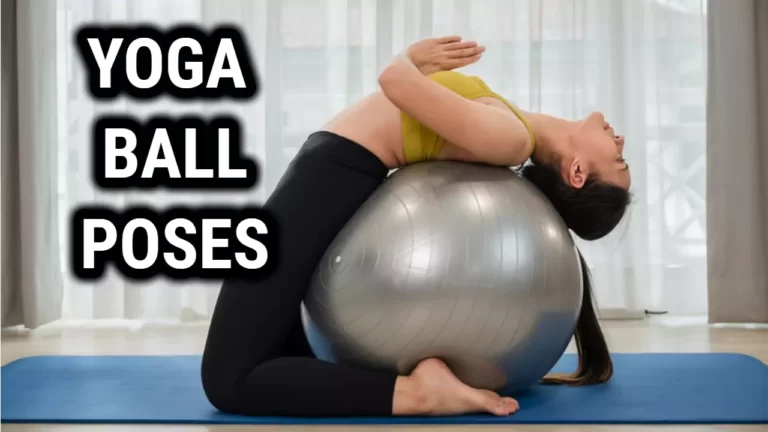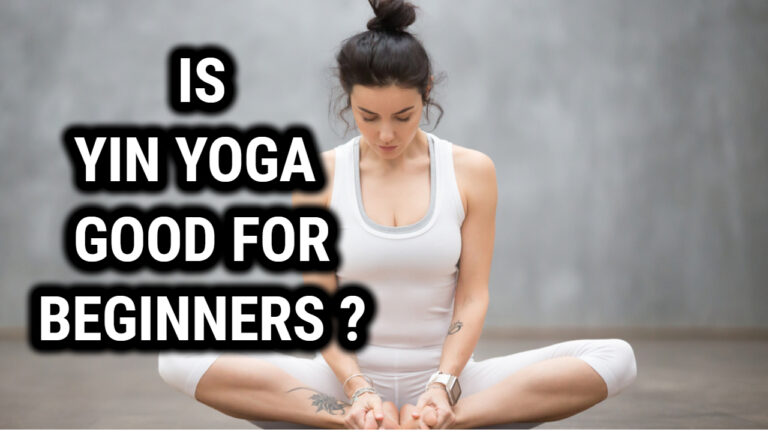Bikram Yoga Poses: Unlock Your Inner Strength and Vitality

Do you want to improve your strength and flexibility? Are you looking for a fun way to stay in shape? If so, Bikram yoga poses may be the perfect workout for you.
Bikram yoga is an energizing practice that combines a series of postures with deep breathing and heat. With a combination of both physical and mental benefits, it’s no wonder why this form of yoga is growing increasingly popular.
Bikram yoga poses are designed to stretch and strengthen the body while improving balance and concentration. Developed by Bikram Choudhury in the 1970s, these 26 postures focus on working all parts of the body while maintaining proper alignment.
This sequence is done in a room heated to around 105 degrees Fahrenheit with 40% humidity which helps increase circulation throughout the body and allows for deeper stretching.
When practiced correctly, Bikram yoga poses can lead to many health benefits such as improved flexibility, increased muscle tone, improved posture, better circulation and improved breathing capacity.
You don’t need any prior experience to get started either; anyone from beginner to experienced yogi can participate in this practice! So if you’re ready to jump start your fitness routine then read on to find out more about Bikram yoga poses!
Definition Of Bikram Yoga
Bikram yoga is a type of hot yoga, and often referred to as “hot yoga”. The practice was created in the 1970s by Bikram Choudhury and involves completing 26 postures in a heated room. During this 90-minute class, postures are repeated twice – once on each side of the body.
The definition of bikram yoga is an intense form of hot yoga that consists of postures performed in a heated room. Each posture provides practitioners with a physical and mental challenge as they hold each pose for around one minute before transitioning to the next pose.
This type of yoga is designed to help build strength and flexibility while improving balance, focus and concentration, providing physical benefits, bikram yoga can help practitioners to gain psychological benefits such as reduced stress and improved mood.
Benefits Of Bikram Yoga
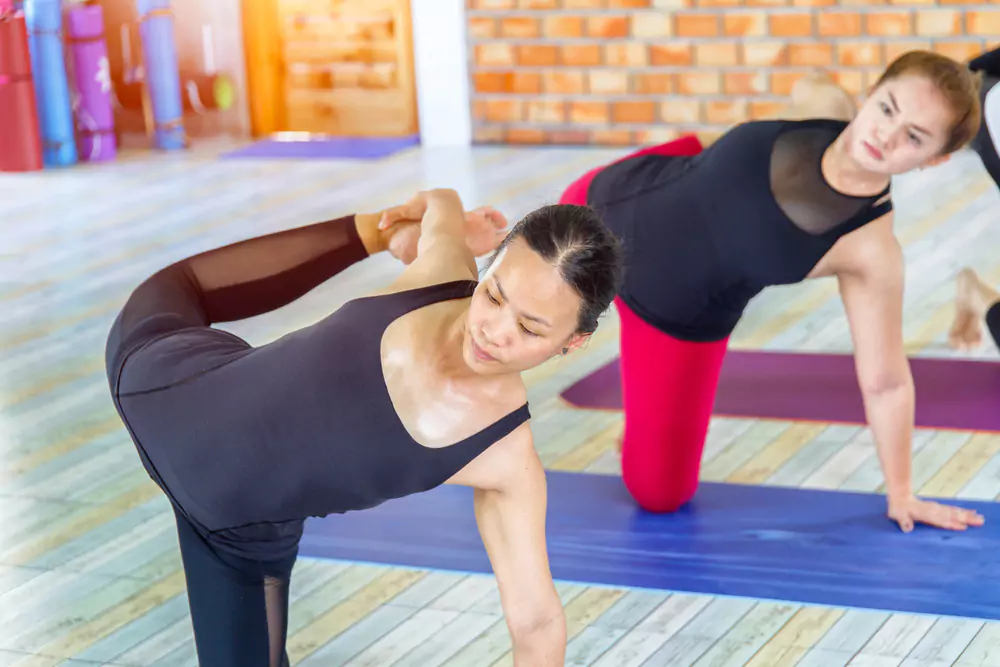
Pleasing practitioners with powerful perks, Bikram yoga brings bountiful benefits to those who practice it. Physical and mental rewards are reaped from regular sessions of this heated exercise, allowing for incredible stress relief as well as health improvements.
First and foremost, the physical benefits of Bikram yoga are plentiful. Participants find that their muscles become more pliant and flexible with each session, enabling them to push themselves further in each pose.
The intense heat during classes helps to ensure that the body is warm enough for deep stretches while also working up a sweat to keep participants feeling invigorated afterwards. Additionally, improved posture is often noticed after regular practice.
Bikram yoga also offers considerable mental benefits. Concentrating on the poses can be incredibly calming and mindfulness-promoting, helping practitioners to focus on the present moment rather than what has been or what will be.
This can lead to improved concentration which carries over into daily life activities such as work. Furthermore, since many of the poses require strength both physically and mentally, practitioners may find themselves feeling more empowered after every class they attend.
Finally, practicing Bikram yoga can help reduce stress levels due to its ability to relax both the body and mind simultaneously.
Taking an hour out of one’s day just for oneself can give them a sense of control over their life and provide much-needed respite from everyday worries or anxieties.
Also, with regular practice comes improved sleep quality which can make a significant difference in how rested one feels each day.
Preparation For Practice
Preparation for your Bikram yoga practice is essential. Before beginning, there are a few steps to ensure you’re ready to start your session.
First, make sure to have the right equipment. You will need a yoga mat, a water bottle to stay hydrated during class, and a yoga block or two if available. It’s also important to stretch beforehand with an appropriate stretching routine.
It’s also important to wear the right clothes. Choose loose fitting clothing that is comfortable and breathable. Avoid wearing any jewelry and long necklaces or anything that could get in the way of your practice. Additionally, it’s best not to wear any restrictive clothing such as jeans or tight tops so that you can move freely and comfortably throughout your practice.
By following these simple steps, you can ensure that you’re ready for your Bikram yoga practice:
- Have the right equipment
- Stretch before beginning
- Wear loose fitting clothes
- Avoid wearing jewelry or restrictive clothing
- You’re all set for an enjoyable and successful session!
Warm-Up Poses
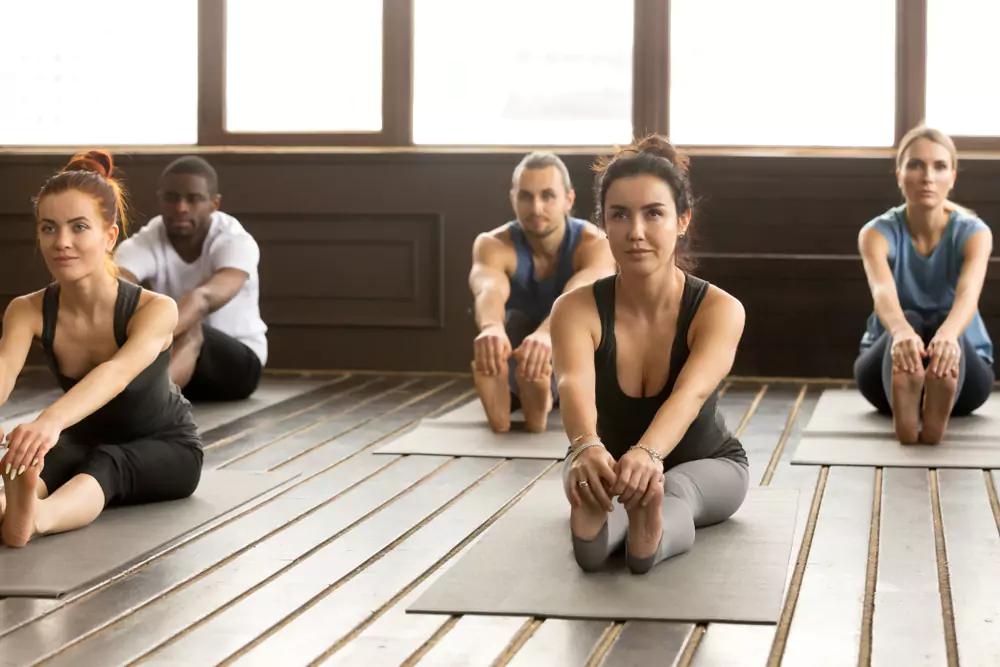
Now that you have all of the essential equipment, it’s time to move on to warm-up poses. In Bikram yoga, warm-up poses prepare your body for the more intense postures.
They help to increase flexibility and range of motion, as well as reduce the chance of injury during practice. There are a variety of warm-up poses available for both beginners and advanced practitioners.
For those just starting out with Bikram yoga, there are some basic beginner warm-up poses that can be modified to suit your individual needs.
These include standing forward bends, shoulder stretches, and cat/cow pose. These poses help to gently open up your body and get it ready for more challenging postures.
Advanced practitioners may incorporate more dynamic movements into their Bikram warm-up routine. This could include sun salutations or twists such as revolved triangle or half lord of the fishes pose. These poses help to further open up your body while also building strength and stamina.
No matter what level you are practicing at, warming up is an important part of any yoga practice. Taking a few minutes before class to do some yoga warm-ups can help ensure that you get the most out of each session.
Doing so will also reduce the risk of any injuries caused by pushing yourself too hard or going into postures without proper preparation.
Standing Postures
Standing postures are an important part of Bikram Yoga. These postures help practitioners to build strength and flexibility, while also promoting balance and meditation. Standing postures can be divided into three main categories: standing balance poses, standing strength poses, and standing flexibility poses.
Standing balance postures focus on finding physical equilibrium. They challenge the body’s ability to stay balanced whilst performing specific movements. Popular examples of standing balance postures include Triangle Pose, Half Moon Pose, and Warrior III Pose. In each posture, the practitioner must maintain steady focus in order to remain balanced throughout the pose.
Standing strength postures involve dynamic movement which requires considerable muscular exertion from the legs and core muscles. These poses help to strengthen the body’s stabilizing muscles that ensure proper alignment during practice. Examples of standing strength postures include Chair Pose, High Lunge Pose, Side Plank Pose and Warrior I Pose. Many practitioners find that these poses are challenging but rewarding when mastered correctly!
Standing flexibility poses require practitioners to open their hips, shoulders and other areas of the body while maintaining a steady stance. Popular examples of these poses include Wide-Legged Forward Fold Pose, Extended Hand-to-Big-Toe Pose, Revolved Triangle Pose and Half Lord of The Fishes Pose. Practicing these poses helps to improve overall flexibility while also increasing awareness of body alignment during practice.
Maintaining focus on breath work will help keep practitioners grounded as they move through their practice with ease. With continued dedication and patience even the most difficult standing postures can be achieved!
Balancing Poses
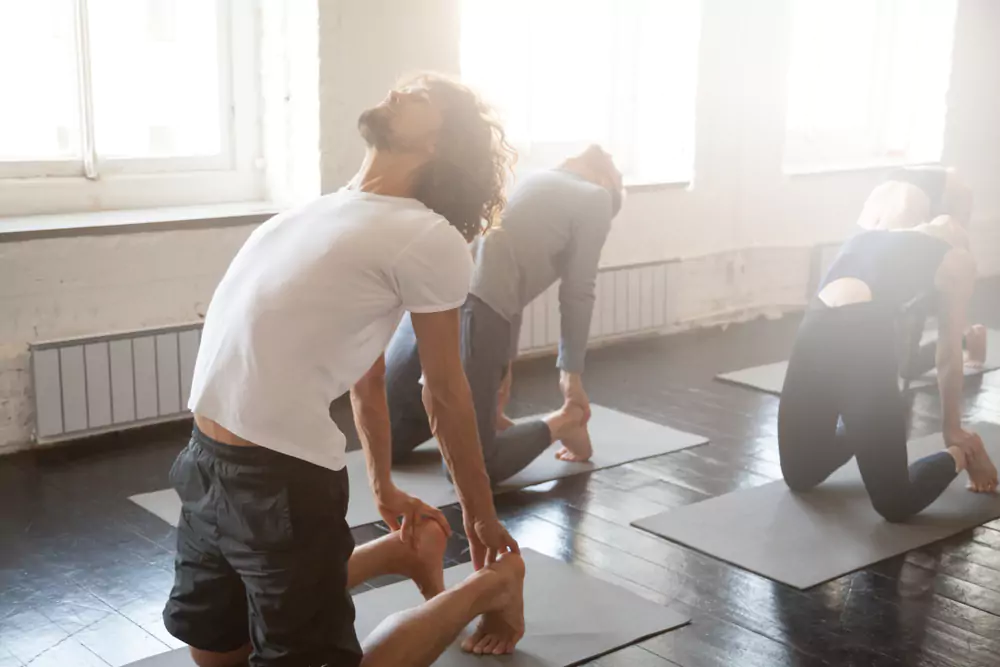
Have you ever wondered what it would be like to practice balancing poses in a Bikram yoga class? Balancing poses are an important part of any Bikram practice to help increase strength and focus. In this section, we will explore the different types of balance poses used in Bikram yoga: standing balance, seated balance, and supine balance.
Standing balance poses are practiced after the standing series sequence has been completed. These poses can range from simple one-legged balances such as Tree Pose to more complex two-legged postures like Half Moon Pose. All these poses require a stable base, strong core muscles, and good concentration to achieve the correct alignment.
Seated balance postures are also used in Bikram Yoga; however, they can be more challenging than standing balances due to the lack of support from the ground. Some examples of seated balancing postures include Eagle Pose and Lord of the Dance Pose. These poses require body awareness and flexibility to maintain perfect posture while balancing on the seat bones.
Supine balance postures are performed while lying down on your back which helps with relaxation as well as increasing body awareness. Examples of these poses include Boat Pose and Bridge Pose which help strengthen the spine and abdominal muscles respectively. This type of pose is beneficial for those who need a break from standing or seated postures but still want to challenge their core muscles and improve their sense of equilibrium.
Balancing poses are an essential part of Bikram yoga practice that help develop strength, focus, flexibility, and body awareness all at once. With regular practice, you will find yourself getting better at maintaining perfect posture when performing these balancing exercises!
Also Read: Kneeling Yoga Poses: Improve Flexibility and Strengthen Your Body
Cool Down And Final Relaxation
The final stage of any yoga sequence is the cool down and final relaxation. After a session of deep breathing and body awareness, it’s important to bring the body back to a state of rest.
We must slowly drift away from the intensity of our practice. We start with taking a few moments to check in with ourselves, connecting to the breath and allowing any lingering energy to be released as we exhale. With each inhale, let us invite peace into our bodies and minds.
It is here at the end that we can reflect on our experience, giving thanks for what was learned or gained and noticing how we feel in this moment. By acknowledging the journey that just took place, we can open up space for growth and transformation. Let us take this feeling with us out into the world.
Safety Considerations
When practicing bikram yoga, it is essential to be aware of safety considerations. Hot yoga, which is a type of bikram yoga, can be very dangerous if proper precautions are not taken. Temperature safety should always be the first priority when performing any kind of hot yoga exercise.
The temperature of the studio should not exceed 105 degrees Fahrenheit and the humidity level should remain at 40%. It is important to hydrate adequately prior to and during your class in order to avoid dehydration and extreme fatigue.
It is also important to note that some poses in bikram yoga may put strain on certain parts of the body such as the lower back and neck so it is important to listen to your body and stop if you experience any discomfort or pain.
Taking breaks between poses can help reduce the risk of injury while still allowing you to receive all the benefits from your practice. Ultimately, it is up to each individual practitioner to decide how far they want to push themselves according to their own physical capabilities and comfort levels.
Related Read: Is Bikram Yoga Good For Toning Your Muscle And Lose Weight?
Conclusion
Bikram yoga is an amazing and powerful practice that can provide a plethora of physical and mental benefits, if done correctly. Not only does it allow us to gain strength, flexibility, and balance, but it also helps us relax and clear our minds.
Preparing for practice is essential in order to ensure a safe and enjoyable experience. From warm-up poses to balancing postures to concluding relaxation, we can all reap the rewards of this incredible yoga practice.
Practicing Bikram yoga is like taking a journey into yourself. You have the power to open up your body and mind in ways you didn’t think were possible. With each posture comes an opportunity for growth and self-discovery that is truly unparalleled.
Plus, the feeling of accomplishment you get after completing your practice is absolutely sublime – it’s like conquering the world.
